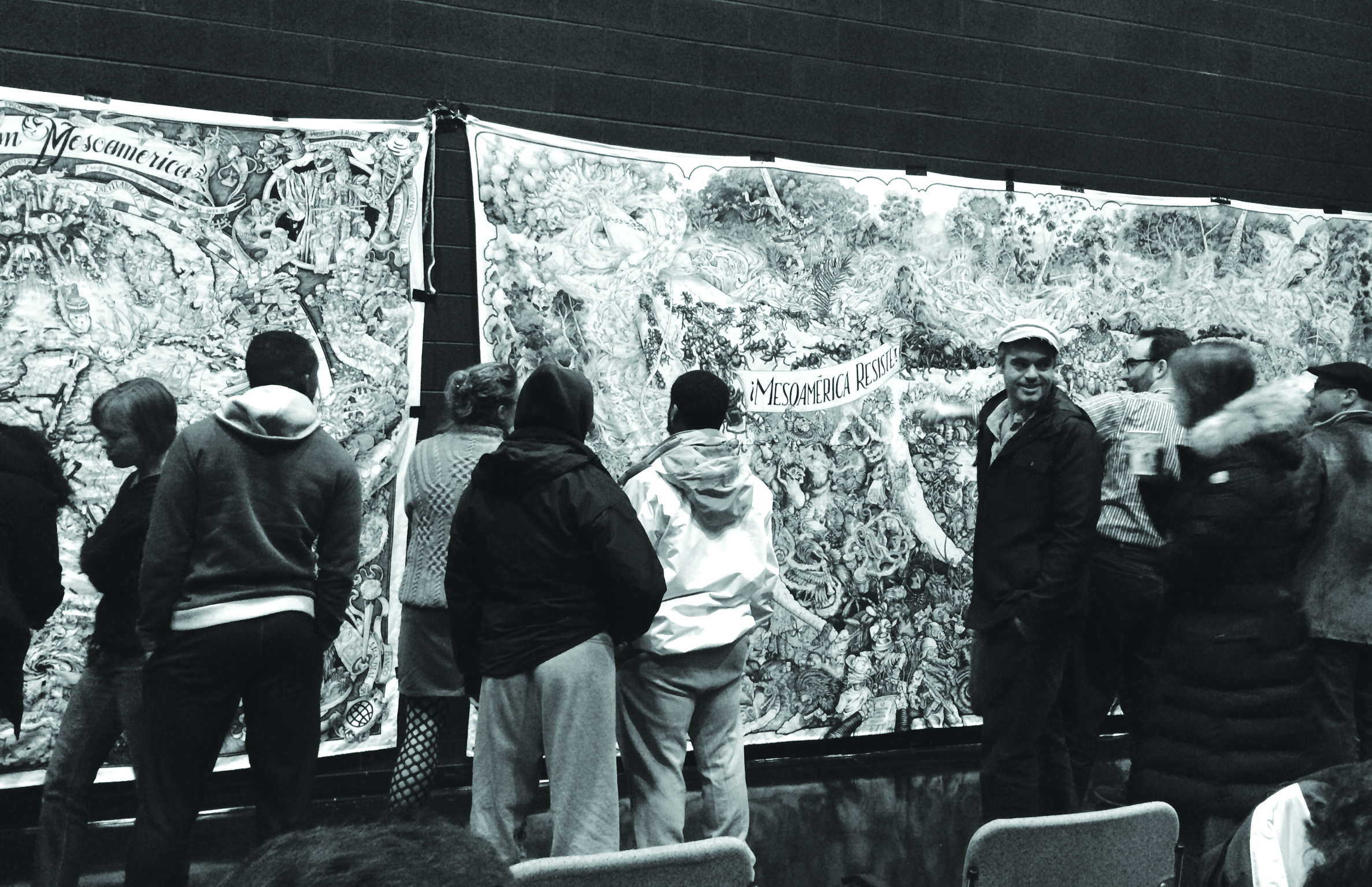By REBECCA DOSER
FEATURES EDITOR
To be(e), or not to be(e): that is the question. The Beehive Design Collective, a non-profit organization that uses beautiful graphics to tell stories regarding resistance to corporate consumerism, toured from Machias, Maine to Canton, New York on Monday, December 2 to engage with SLU students, faculty and Canton community members in an interactive workshop. The Black Box Theater in Griffiths was packed with standing room only as two activists dedicated to “cross-pollinating the grassroots” presented the newest graphic and the third in it’s trilogy titled Mesoamérica Resiste.
The two passionate storytellers presenting to the public are part of a collective group of volunteer artists, illustrators, activists and dancers who come together to build giant black and white graphics, which they use as aids to communicate stories with an intriguing combination of metaphors and layered images. The current trilogy details globalization throughout the western hemisphere in three intricate illustrations. The first called Free Trade Area of the Americas tells a story of the issues surrounding free trade and privatization. Next, the trilogy emerges in its portrayal of the U.S. funded war on drugs. Finally, this past summer the last image of the trilogy was completed. Mesoamérica Resiste is an image used to share the story of collectivism, inspiration and the exploration of colonialism throughout history.
The complex two-fold graphic maintains many elements of an old world map. At first glance, you get a sense of storming across the ocean, getting sucked into the depths of cheap consumerism in North America. The image clearly portrays the driving factors behind what is now the epicenter of global trade. This massive graphic spanning the entire back wall of The Black Box Theater depicts the Southern states of Mexico all the way to Panama.
The story starts with an exploration of colonialism through its roots in history in connection with the industrialized industries that attract millions today. Moving along through the in-depth graphic lies elements of resistance and alternatives to the top-down plans. There are many captivating images within this illustration that took nine years to complete. One is the compass rose, which holds great power within the entire work of art. The compass is pointed North to the Starbucks barista icon and the Chiquita Banana label, thus portraying how two major sources of consumerism and exploitation stand to hold such great power in today’s society.
Another intriguing element of the Mesoamérica Resiste is its representation of trianglular trade through the images of three ships. The first one is carrying enslaved people while the second one is exporting sugar to be made into rum, bringing immense wealth to West Africa. The third ship emphasizes the influx of wealth even further in its immensity of gold and silver. All three ships combined portray elements of modern legacies. The most unique aspect of this image and the story behind it is the hidden surveillance camera snuck into the illustration. This serves to show the shift from slavery to prison tactics and law enforcement, specifically focusing on the terrible working conditions and racist treatment.
“This map describes a whole world view where life is seen as a stolen commodity,” one presenter says. She outlines the way things are now and how they must be understood in the context of history through a complex grid of graphics.
The unique concepts behind each image in Mesoamérica Resiste are so fascinating, that they almost thrive on the storyteller in order to grasp their full meaning. For example, at the very bottom of the map, one sees various characters seated around a table eating cake. Upon first glance, this image may seem typical, lacking any underlying meaning. But look closer. Listen to the story. You find that these characters are all hidden behind smiling animal masks exemplifying various elements of corporate globalization: a golf club, pharmaceutical company, bottled water, timber, and gas. They are all portrayed as characters centered around this table, each reaching out with a different type of claw to grab a piece of cake from the center. Each claw is different (ex. a gas pump or a bottle cap) and depicts a different level of instability, further projecting a new wave that affects the ability to maintain a consistent “green” mentality.
Overall, this graphic document casting a set of characters that includes over 400 species of insects, animals and plants, is unlike any illustration to a story that I have ever seen before. The ability to deconstruct a portable mural such as Mesoamérica Resiste in order to portray the social and environmental struggles throughout the history of colonialism is impeccable. Be(e)lieve it or not, this was an event that you did not want to miss.



